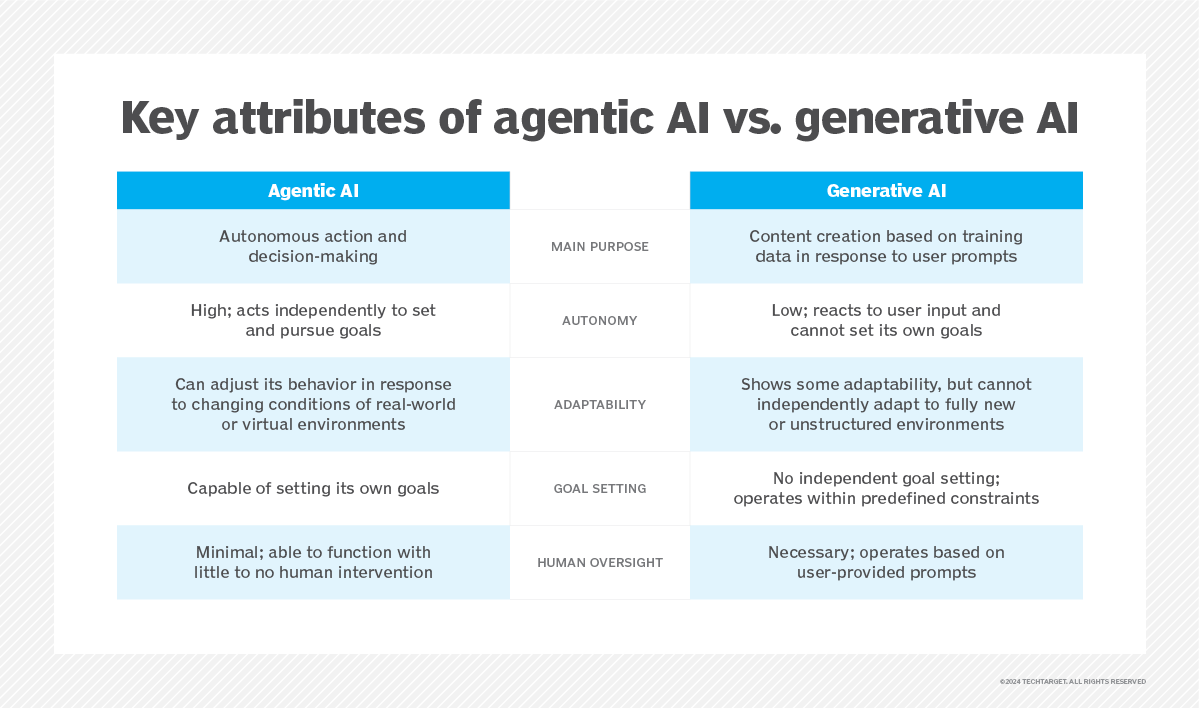What is AI agent memory? Types, tradeoffs and implementation
AI agents with short- and long-term memory leapfrog simple task-oriented assignments into areas of autonomy, pattern recognition, personalization and strategic business planning.
AI agent memory is the ability of an AI agent to access, use and learn from past interactions with users and other AI agents and AI systems.
Memory is vital for an AI system to recognize patterns, preserve context and adapt to changes. By storing and recalling past interactions, an AI agent can accelerate AI agent performance because common information or parameters don't have to be re-entered, improve AI agent perception by recognizing differences in choices or requests, and enhance AI agent decision-making by adapting and refining outputs as inputs change over time.
AI agents don't require memory nor typically remember things by default. A simple reflex agent such as a home thermostat doesn't need to know the room temperature settings for the last 30 days, so memory isn't required. But memory capabilities are essential for such task-oriented AI systems as agentic AI workflows requiring access to historical and real-time data, outcome assessments, user feedback and adaptive learning techniques.
Adaptive systems such as smart home thermostats can use memory to learn historical patterns and prior user preferences, so the smart device can predict user choices, optimize activity and adapt to changing situations in more intelligent ways. AI agent memory is designed and implemented to provide high efficiency, so data can be stored and retrieved with low latency while minimizing data storage requirements.
How does AI agent memory work
AI agent memory can be implemented in many varied ways, depending on developer skills and AI agent needs. A simple example of AI agent memory and system orchestration would be a disk-based database service, such as MongoDB, integrated with a retrieval-augmented generation (RAG) layer in an orchestrated agentic AI workflow. The RAG layer is fundamentally stateless but provides multiple capabilities, including access to a large language model (LLM), an external application, short-term and long-term memory, and external data sources.
In this example, user queries are ingested through the application's UI. APIs pass the query across the agentic layer to a prompt manager where the query is parsed into tokens, which are forwarded to an LLM for processing. The LLM returns results to the agentic layer which might call for memory access. Short-term memory can be read and written through a state client that basically provides scratchpad management of the current conversation or exchange taking place. Access is typically frequent and fast and accesses a relatively small memory space. Long-term memory can be read and written through a retriever that allows long-term memory to sustain context, build understanding and form reasoning over time. Access is typically less frequent but can be extremely large and experience more memory latency. Data is exchanged across the orchestrated agentic AI layer where AI agents and machine learning (ML) models can process the data and render results, which can be passed back to memory as needed and exchanged with the user through the UI in the calling application.
AI agent memory can be implemented as a straightforward resource -- even a cloud-based database -- and integrated as a service to support the AI agent. The choice and design of the memory defines the memory type, either short-term memory or a specific form of long-term memory.
Importance of memory in AI agents
Memory is a crucial part of AI agents because it provides reasoning and learning that's emblematic of AI systems. Adding short-term and long-term memory to AI agents can support major AI capabilities including the following:
- Pattern recognition. Memory can help establish context by finding relationships between past and current interactions such as user queries. Accurate and meaningful context enables the AI agent to respond and navigate complex requests far more quickly and accurately than starting each interaction from scratch.
- Historical interaction. Memory allows AI agents to access and process past interactions with users and other AI agents. The ability to see past interactions, preferences and decisions can guide the AI toward more accurate and efficient outcomes in the future.
- Domain knowledge. Memory provides the ability to access extensive general and industry-specific knowledge bases. By adding knowledge and expertise to the decision-making process, AI agents can provide better reasoning and decision-making, especially when extensive background knowledge or industry-specific expertise is required.
- Personalization. Memory allows the AI agent to learn about users by incorporating their preferences and previous choices into tailored environments and user-driven outcomes, making memory a core element of evolving tools such as AI assistants.
- Learning and adaptation. Memory is the core of learning and adaptation, so AI agents can learn from past decisions, outcomes, experiences and interactions, then use that information to improve accuracy and performance over time should user preferences or business conditions change.
- Autonomy support. Autonomy, the ability of an AI agent to make decisions and take actions without human intervention, is impossible without memory. Otherwise, AI would simply be another form of task automation, blindly following established rules and guidelines.
- Collaboration. Memory also allows AI agents to interact with other agents and systems while maintaining context and ensuring common goals. Memory is a core element of agentic AI workflows and autonomous AI systems.

Types of AI agent memory
AI agents can use two broad types of memory: short-term memory and long-term memory. Each type of memory can be designed in different common variations.
Short-term memory
Short-term AI agent memory (STM) is fundamentally a scratchpad or working memory that can maintain context across multiple exchanges or several previous messages within a session. It provides a level of continuity to the AI exchanges and prevents a user from re-entering details or requests more than once.
STM is easily implemented as a rolling buffer, or a context window in LLMs, that holds a finite amount of data before being overwritten again from the start. But STM is considered volatile and its contents are lost when the AI agent completes a session. While it offers a simple option for AI agent memory, STM is inadequate for long-duration uses such as learning or personalization.
Long-term memory
Long-term AI agent memory (LTM) is intended to provide permanent, high-capacity storage for user requests, preferences, information and exchanges across sessions. Although LTM access can be slower than STM, long-term retention enables AI agents to learn and become more personalized, intelligent, predictive and accurate over time.
LTM is often implemented with well-established technologies, like databases and knowledge graphs, and can include vector embeddings. LTM also relies heavily on RAG techniques that enable the AI agent to locate required information from a stored knowledge resource to generate improved responses.
There are typically three types of long-term AI agent memory, including the following:
- Episodic LTM. This LTM stores data in terms of past events or experiences and is particularly effective for AI that must perform case-based reasoning -- using past events, actions and outcomes to learn and improve future decision-making. Episodic LTM stores data in a highly structured format, which can be quickly found and readily processed by the AI agent when making decisions, making it well-suited for activities requiring AI agent personalization.
- Semantic LTM. This LTM supports long-term factual knowledge, which can aid an AI agent in gleaning context and enhancing reasoning. It allows AI agents to access a much broader range of domain knowledge, such as legal or medical information, that often involves definitions, facts, guidelines and rules. Semantic LTM can be implemented using knowledge bases, vector embeddings or symbolic AI and offers value in expertise-based AI.
- Procedural LTM. This LTM stores and recalls sequences of actions such as rules, skills or other learned behaviors. It enables the AI agent to automatically perform repetitive or previously completed complex tasks without the need to deliberately reason or plan the task each time. It's basically muscle memory for AI systems, which reduces computational demands and speeds responses. Procedural LTM is important for AI learning and automation.
Tradeoffs in AI agent memory design
There are various types of memory to handle different tasks, and each memory type can be implemented in countless ways to meet the needs of an AI agent and the goals of an AI system. Some of the more important considerations and tradeoffs in AI agent memory include the following:
- Memory type: STM vs. LTM. STM is used to maintain context and continuity during a single session or task. LTM retains information across sessions and tasks, so an AI agent can learn, adapt and glean insights. LTM types include episodic, semantic and procedural, each providing unique benefits to an AI agent. STM uses relatively little memory capacity and can offer fast performance, while LTM can use extensive memory capacity, which introduces latency and inefficiency to the storage and retrieval process.
- Depth vs. efficiency. LTM can offer significant learning and contextual comprehension to AI agents. More LTM can enable greater contextual depth, better decision-making and more meaningful user interactions. But more memory is not always better. Greater memory depth demands far greater memory capacity, which can drive higher memory and computational costs and reduce memory access performance. An AI agent that requires the fastest response times and can tolerate a little less intelligence might benefit from less LTM.
- Reliability vs. autonomy. Smaller and simpler memory choices can improve memory reliability, resulting in more predictable and consistent AI agent outcomes, but will limit the amount of context, understanding and creativity the agent can provide. Larger and more sophisticated memory choices allow the AI agent to provide deeper, more flexible and autonomous outcomes, yet increase the risks of erratic or unpredictable outcomes like hallucinations.
- Flexibility vs. efficiency. The types and amounts of memory provided to AI agents can affect the balance between flexibility and efficiency. Less memory can support AI agents with a relatively narrow and carefully defined range of tasks while providing cost and performance efficiencies but will make an AI agent less flexible and dynamic in complex situations. More memory can support AI agents with a broader, more adaptable and dynamic scope, yet it will cost more and might yield reduced performance characteristics.
- Cost vs. performance. The choice of memory implementation will impose its own set of cost-performance tradeoffs. A MongoDB database, for example, provides more space and reliability at less cost. By comparison, DynamoDB can impose high storage costs and item size limitations, leading to complex storage situations.
- AI agent framework. The choice of AI agent framework can impose unique tradeoffs surrounding memory design and implementation. CrewAI, for example, is noted for excellent role separation and delegation but doesn't support modular memory, while LangChain can support extensive abstraction but imposes significant overhead, which can affect performance. Other AI agent frameworks, such as AgentVerse, provide strong capabilities for AI agents but are relatively new and feature limited.
Implementing AI agent memory
Developers can use a wide range of approaches for implementing AI memory, which typically involves a mix of external storage, access mechanisms and feedback or learning requirements.
A common approach to AI memory implementation is when short-term and long-term memory are based on disk storage accessed and managed through a database. Short-term memory is accessed through a state client mechanism, which fundamentally allows the AI agent to be stateful whereby it remembers interactions and retains or updates the context of a current conversation such as chat history or current data from relevant sources. Long-term memory is accessed through a retriever tool mechanism, which searches and retrieves relevant long-term information from local and external sources as part of the RAG pipeline. This memory retains outcomes, preferences and feedback, allowing the AI agent to learn, adapt and optimize its outcomes.
AI agents vary widely in their complexity and requirements, so specific memory implementations will depend on the agent's application, architectural design and learning capabilities. Developers can use several popular frameworks for building memory-enabled AI agents, including the following:
- AutoGen supports modular and flexible multi-agent systems and facilitates collaboration between agents and users.
- CrewAI provides a lightweight platform for the development of collaborative AI agents.
- Haystack is a specialized framework for AI agent information retrieval with semantic search and conversational capabilities.
- LangChain can integrate memory (using sophisticated vector databases), APIs and workflows.
- LangGraph can support the construction of hierarchical memory systems for AI agents, enabling excellent learning and adaptation over time.
- Letta is an open-source framework for creating stateful LLM agents with support for transparent long-term memory management.
- LlamaIndex is suited for connecting data to LLMs and building AI agents intended for industry-specific tasks where specialized knowledge is required.
- Memary is an open-source framework intended to simulate human memory in AI agents with a strong emphasis on memory.
- Rasa is an open-source framework for creating chatbots and other conversational AI agents with an emphasis on context handling and intent recognition.
- Semantic Kernel provides a framework for integrating AI agents into existing applications and integrating LLMs with tools and memory to develop powerful AI agents.
How can businesses use AI agent memory
Memory is a deeply enabling component of AI agents and AI systems, allowing AI to provide more context-rich, adaptive, personal and meaningful interactions or outcomes. Although the detailed uses of AI agent memory are almost limitless, there are numerous broad categories of how businesses can use memory.
- Expanding understanding and knowledge. LTM is essential for developing greater understanding and knowledge, so AI agents can provide domain expertise and develop comprehensive knowledge bases necessary for effective vertical AI agents. Semantic memory, for example, can store facts, definitions and rules that are critical to some vertical AI agents.
- Providing better decision-making. AI agents are still founded on ML algorithms and analytics. LTM enables AI agents to access vast amounts of historical data to find relationships and patterns that can provide insight into future trends, make recommendations, assess risks, find opportunities to optimize and result in more informed business outcomes.
- Improving personalization. LTM stores historical interactions, preferences and purchasing details, so AI agents can tailor product recommendations, personalize responses and support, and even predict future needs, greatly expanding customer engagement and improving the UX.
- Supporting greater AI complexity. AI agents can work alone but are increasingly orchestrated into larger and more integrated AI systems capable of more complex workflows and operations. Memory is central to success in orchestration, allowing data, context and decisions from one agent to be readily shared among other agents.
- Enhancing workflows. AI agent orchestration is adept at composing and optimizing workflows. Memory not only can retain the workflows but also gather and process outcomes -- combined with user preferences and roles -- to produce optimized workflows. Enhanced workflows can retain more data and context between tasks, which reduces redundant work and provides greater workflow automation for more consistent and compliant workflows.
- Strengthening learning and adapting capabilities. Memory is the foundation of learning and adaptation, allowing AI agents to remember, assess and consider previous outcomes and their levels of success in planning and executing future tasks. Memory also provides access to historical data, such as customer information, to support better analyses and evaluation of current situations and make meaningful changes as needs and data change.
Stephen J. Bigelow, senior technology editor at Informa TechTarget, has more than 30 years of technical writing experience in the PC and technology industry.







